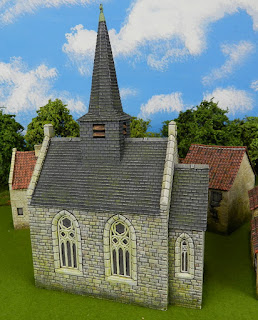Here's the second post showing the newly photographed Belgian buildings I made 10-12 years back. Churches today, houses and a Waterloo landmark to come. I made these to fit two periods that my friends were collecting armies for: the Marlburian period and the Waterloo campaign, but they would be fine for a broader period: the Wars of Religion in the 16th Century, the Thirty Years War and the War of Austrian Succession a century later. The brick or stone buildings such as these churches wouldn't be out of place as late as 1914 or the Blitzkrieg of 1940. In fact the central region of Belgium must have the sad distinction of being more frequently fought over than any other area of Europe.
Anyway, the first church is in one classic style of construction, the pleasing combination of brick with light stone "corners" and "openings". The model was almost entirely made from Wills plastic sheets: brick, tile and even the corner stones. The windows were my resin castings though.










A couple of lovely churches there John and of course, assuming buildings from the 16/17 century have survived war, revolution and local authority planning departments, they are still to be found across Europe today, so are perfectly acceptable in any conflict after the time of their original construction!
ReplyDeleteWow, lovely churches, very immersive and detailed buildings!
ReplyDeleteBeautifully done John, with the brick one being my favourite of the two. The weathering at the base is very nicely done and good to see, which reminds me that maybe I should do it on my 6mm buildings!
ReplyDeleteVery nice indeed!
ReplyDeleteThanks, folks. I agree the brick one does look the more attractive!
ReplyDelete